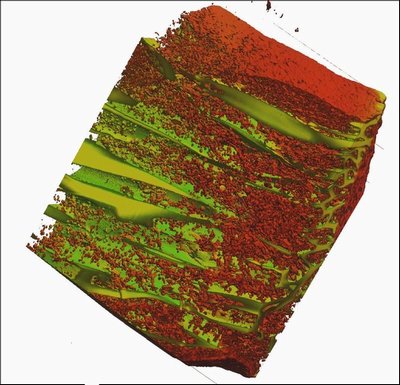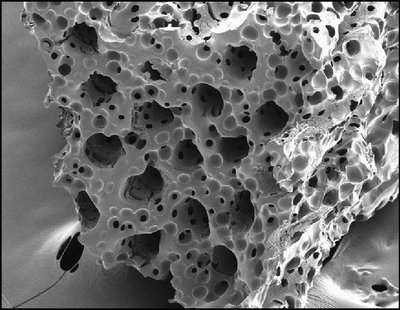August 9, 2010
A strategy to fix a broken heart
These days people usually don’t die from a heart attack. But the damage to heart muscle is irreversible, and most patients eventually succumb to congestive heart failure, the most common cause of death in developed countries.
Stem cells now offer hope for achieving what the body can’t do: mending broken hearts. Engineers and physicians at the University of Washington have built a scaffold that supports the growth and integration of stem cell-derived cardiac muscle cells. A description of the scaffold, which supports the growth of cardiac cells in the lab and encourages blood vessel growth in living animals, is published this week in the Proceedings of the National Academy of Sciences.
“Today, if you have a heart attack there’s nothing that doctors can do to repair the damage,” said lead author Buddy Ratner, a UW professor of bioengineering. “You are, in essence, sentenced to a downhill slide, developing congestive heart failure that greatly shortens your lifespan.”
“Your body can’t make new heart cells, but what if we can deliver vital new cells in that damaged portion of the heart?”
Ratner and his colleagues built a tiny tubular porous scaffold that supports and stabilizes the fragile cardiac cells and can be injected into a damaged heart, where it will foster cell growth and eventually dissolve away. The new scaffold not only supports cardiac muscle growth, but potentially accelerates the body’s ability to supply oxygen and nutrients to the transplanted tissue. Eventually, the idea is that doctors would seed the scaffold with stem cells from either the patient or a donor, then implant it when the patient is treated for a heart attack, before scar tissue has formed.
Other heart scaffolds or tissue patches currently being developed combine cardiac muscle cells and two other types of cells needed to kick-start the growth of blood vessels and connective tissue. Preparing each type of cells is an enormous amount of work, so a scaffold that requires just one type of cell, like this one, would be significantly cheaper and easier to use.
Ratner’s scaffold is a flexible polymer with interconnected pores all of the same size. This one also includes channels to accommodate cardiac cells’ preference for fusing together in long chains. Researchers first verified the design using chicken embryonic heart cells, and confirmed that the scaffold could support heart tissue growth at concentrations similar to those in living heart tissue.
They then seeded the scaffold with cardiac muscle cells derived from human embryonic stem cells. These cells survived and collected in the channels. Over five days, the cardiac muscle cells multiplied faster in the scaffold environment than other cell types, and could survive up to 300 micrometers (about the diameter of four human hairs) from the scaffold edge — an important point if the scaffold is to integrate with the body.
The cells expressed two proteins associated with muscle contraction and could contract with sufficient force to deform the scaffold.
Researchers also implanted a bare scaffold into a living rat’s heart to verify the scaffold’s biocompatibility. Results showed that after four weeks the heart had accepted the foreign body, and new blood vessels had penetrated into the scaffold.
Why blood vessels penetrate so well is unknown. One hypothesis involves the macrophage, a cell in the immune system, and the size of the pores, which seems to be critical. The macrophages first attack the foreign body as an invader and try to digest it. They enter the pores and are themselves entrapped. At this point the macrophage seems to switch from its attack mode to its healing mode. The team is now investigating the blood vessel formation.
Heart tissues need a rich blood supply, and that’s been one of the limiting factors to heart repair and vascular tissue engineering, said co-author Chuck Murry, professor of pathology and bioengineering.
“The first thing that transplanted heart cells have to do is survive. And when you transition them from a culture dish to the body, initially they don’t have a blood supply. So we have to promote the host blood supply as fast as possible,” Murry said.
“We’re very optimistic that this scaffold will help keep the muscle cells alive after implantation and will help transition them to working heart muscles,” Murry said.
The scaffold is made from a jelly-like hydrogel material developed by first author, UW bioengineering doctoral student Lauran Madden. A needle is used to implant the tiny (third of a millimeter wide by 4 millimeters long) scaffold rods into the heart muscle. But the scaffold can support growth of larger clumps of heart tissue, Madden said.
The next steps will involve adjusting the scaffold degradation time so that the scaffold degrades at the same rate that cardiac cells proliferate and that blood vessels and support fibers grow in, and then implant a cell-laden scaffold into a damaged heart.
“What we have now is a really good system going in the dish, and we’re working to transition it to in the body,” Madden said.
Beat BioTherapeutics, a Seattle startup co-founded by Ratner, Murry and co-author Michael Laflamme, a UW assistant professor of pathology, plans to license the technology to help bring it to patients.
Co-authors are Eric Sussman, Janet Cuy and Kip Hauch in UW bioengineering, Sarah Dupras and James Fugate in UW pathology, and Derek Mortisen, a UW chemical engineering graduate.
###
For more information, contact Ratner at 206-685-1005 or ratner@uweb.engr.washington.edu and Murry at 206-616-8685 or murry@uw.edu.
Talk by Charles Murry on ResearchChannel: http://www.researchchannel.org/prog/displayevent.aspx?rID=29197&fID=567
Talk by Buddy Ratner on UWTV: http://www.uwtv.org/programs/displayevent.aspx?rID=20222
The article is available at http://www.pnas.org/content/early/2010/08/02/1006442107.abstract.


